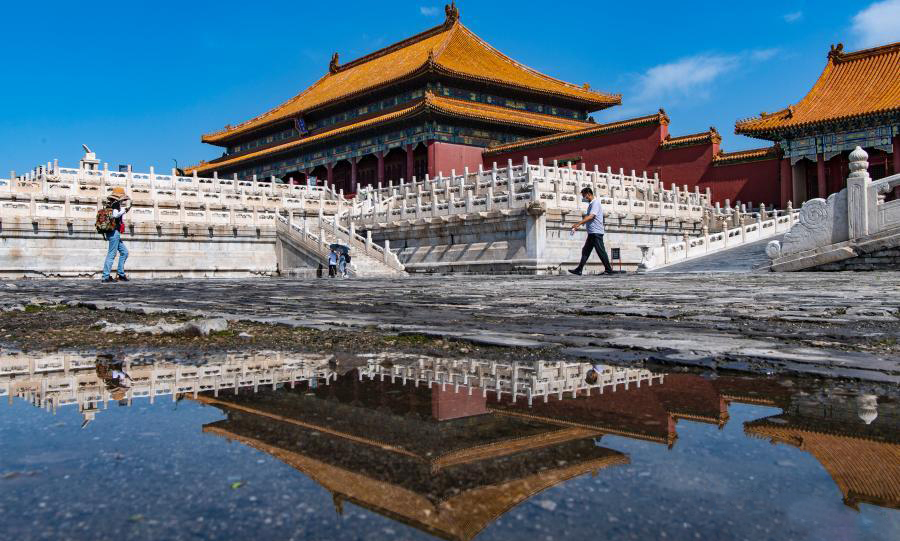Western media should learn to put Chinese economy into perspective
BEIJING, July 16 (Xinhua) -- Despite facing mounting downward pressure from a lingering COVID-19 pandemic, a stormy world economy and other stiff challenges, the Chinese economy in the second quarter has still managed to secure positive growth, showed data released Friday by China's National Bureau of Statistics.
Apart from that, in the first half of this year, China's value-added industrial output went up 3.4 percent, fixed-asset investment jumped 6.1 percent, and foreign goods trade shot up 9.4 percent.
Prior to the publication of those numbers, some Western media sought to exaggerate the problems facing the Chinese economy, and paint an utterly dark picture for the country's future economic viability.
Now that China's economy is regaining foot, the momentum for recovery has proved once again that those Western demagogues are as stubborn as they are selectively blind to China's ability to handle compounding crises and unexpected shocks.
The steady recovery of the world's second-largest economy is surely welcome news in this era of uncertainties. Yet it is hard-won considering the complex international environment and the impact of the COVID-19 outbreaks at home and other factors. The bouncing back also indicates that the fundamentals of the Chinese economy, including its strong resilience, enormous potential, vast room for maneuver and long-term sustainability, remain intact.
Meanwhile, China has been improving the quality of its economic growth by prioritizing high-quality development. For example, growth in the high-tech manufacturing sector jumped 9.6 percent. The value-added output of information transmission, software and information technology services rose 9.2 percent, while financial services grew 5.5 percent.
China has performed notably well compared with other major economies. The June CPI for the United States marked the largest 12-month increase since November 1981, and inflation for the eurozone hit a record high of 8.6 percent in the year to June. While experts warn both economies are "increasingly likely" to slide into recession, China has successfully kept its consumer prices stable, its factory-gate inflation eased for the sixth straight month, and its major economic indicators bounced back in June.
The resilience of the Chinese economy is made possible with a raft of targeted policies. For instance, the Chinese government unveiled 33 measures in May to stabilize the economy, covering policies on investment, consumption, food and energy security, industrial and supply chains, and people's livelihoods.
China has pledged that it will adhere to a people-centered development philosophy. It means that the country will always be ready to protect people's lives even though sometimes it means temporary economic cost.
Given China's vast population, the consequences would be unimaginable if it adopted such pandemic prevention and control policies as the so-called herd immunity approach. That is why Beijing has implemented the dynamic zero-COVID policy while maneuvering to shore up the economy and ensure that people's livelihoods are affected as little as possible.
To help industries, individually owned businesses and micro-, small- and medium-sized enterprises hit hard by the pandemic, Beijing has rolled out detailed measures to stabilize market entities, keep payrolls stable and boost job creation. A total of 6.54 million new urban jobs were created in the first half of the year.
China has also been using policy tools to advance reforms and stimulate innovation to grow its economy effectively. As The Economist, a weekly news magazine, noted in an April article, "the government is nurturing thousands of groups, big and small, in the fields of data science, network security and robotics," which are working to "upgrade China's industrial infrastructure."
And at this difficult moment when unilateralism and economic nationalism are rearing their ugly heads, China has stayed committed to opening-up and cooperation. The start of trading exchange-traded funds under the mainland-Hong Kong stock connect programs in early July was the latest example of China opening its arms wider to welcome global investors.
Agustin Carstens, general manager of the oldest international financial institution, the Bank for International Settlements, said China's resilient economy continues to be an engine of global growth.
Looking into the future, it has to be admitted that the foundation for further recovery of the Chinese economy is yet to be consolidated, and the risk of global stagflation continues to rise.
However, with great potential as well as proven resilience, China still enjoys a promising future of long-term growth. And instead of sticking to their prejudices, those China-sceptics in the West should learn to put the Chinese economy into perspective.
Photos
Related Stories
- Factbox: Data highlights of Chinese economy on recovery track
- China's economy expected to improve amid supportive policies in H2: report
- Eurozone economies responding economic turbulence unevenly, raising challenges for ECB
- China's chemical fiber industry posts growth in revenue
- Pessimism about U.S. economy grows: poll
- CPC steers Chinese economy in resilient recovery despite challenges
- China capable of coping with the unexpected in meeting growth target: economic planner
- Americans cut spending as three quarters have negative views on economy
- Three reasons why financial institutions are optimistic on China's economy
- Multinationals still full of confidence in China's economy
Copyright © 2022 People's Daily Online. All Rights Reserved.









